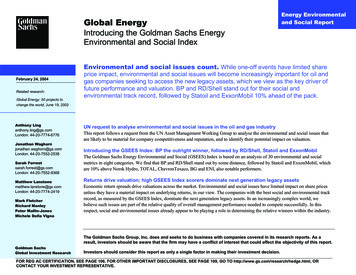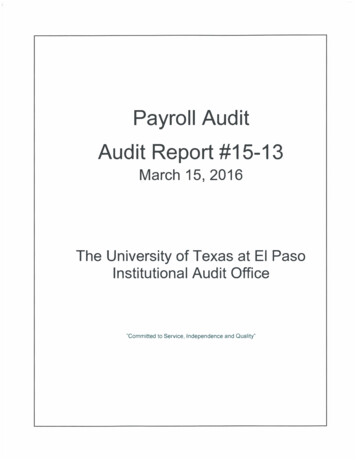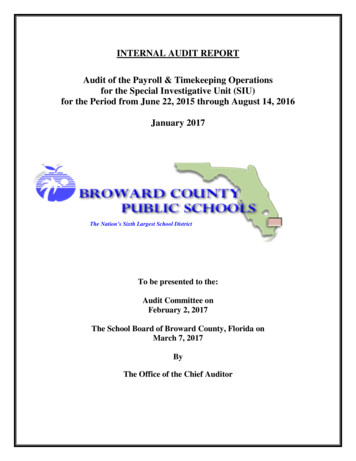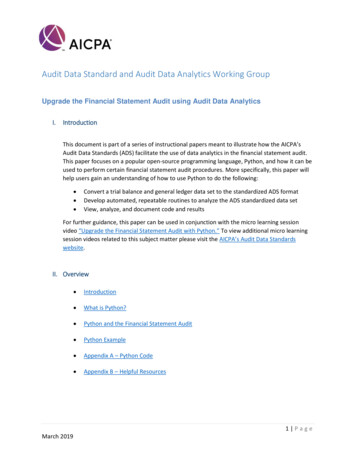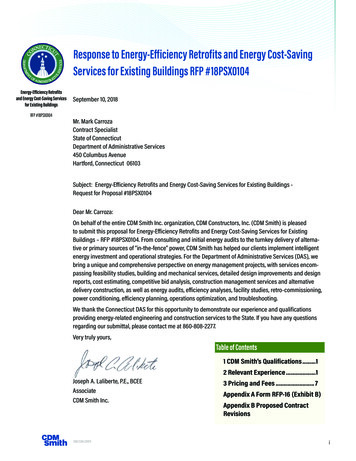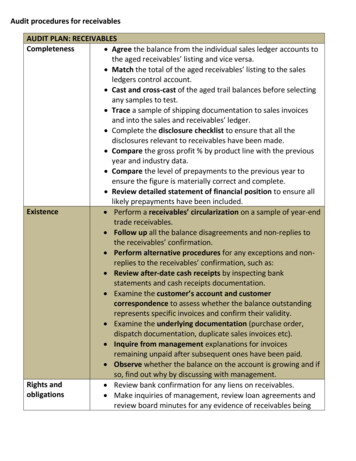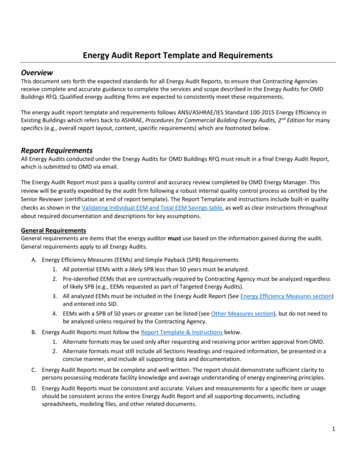
Transcription
Energy Audit Report Template and RequirementsOverviewThis document sets forth the expected standards for all Energy Audit Reports, to ensure that Contracting Agenciesreceive complete and accurate guidance to complete the services and scope described in the Energy Audits for OMDBuildings RFQ. Qualified energy auditing firms are expected to consistently meet these requirements.The energy audit report template and requirements follows ANSI/ASHRAE/IES Standard 100-2015 Energy Efficiency inExisting Buildings which refers back to ASHRAE, Procedures for Commercial Building Energy Audits, 2nd Edition for manyspecifics (e.g., overall report layout, content, specific requirements) which are footnoted below.Report RequirementsAll Energy Audits conducted under the Energy Audits for OMD Buildings RFQ must result in a final Energy Audit Report,which is submitted to OMD via email.The Energy Audit Report must pass a quality control and accuracy review completed by OMD Energy Manager. Thisreview will be greatly expedited by the audit firm following a robust internal quality control process as certified by theSenior Reviewer (certification at end of report template). The Report Template and instructions include built-in qualitychecks as shown in the Validating Individual EEM and Total EEM Savings table, as well as clear instructions throughoutabout required documentation and descriptions for key assumptions.General RequirementsGeneral requirements are items that the energy auditor must use based on the information gained during the audit.General requirements apply to all Energy Audits.A. Energy Efficiency Measures (EEMs) and Simple Payback (SPB) Requirements1. All potential EEMs with a likely SPB less than 50 years must be analyzed.2. Pre-identified EEMs that are contractually required by Contracting Agency must be analyzed regardlessof likely SPB (e.g., EEMs requested as part of Targeted Energy Audits).3. All analyzed EEMs must be included in the Energy Audit Report (See Energy Efficiency Measures section)and entered into SID.4. EEMs with a SPB of 50 years or greater can be listed (see Other Measures section), but do not need tobe analyzed unless required by the Contracting Agency.B. Energy Audit Reports must follow the Report Template & Instructions below.1. Alternate formats may be used only after requesting and receiving prior written approval from OMD.2. Alternate formats must still include all Sections Headings and required information, be presented in aconcise manner, and include all supporting data and documentation.C. Energy Audit Reports must be complete and well written. The report should demonstrate sufficient clarity topersons possessing moderate facility knowledge and average understanding of energy engineering principles.D. Energy Audit Reports must be consistent and accurate. Values and measurements for a specific item or usageshould be consistent across the entire Energy Audit Report and all supporting documents, includingspreadsheets, modeling files, and other related documents.1
Calculations and Energy Modeling RequirementsA. Calculations used in analyses must be supported with sufficient detail and include justification of allassumptions. Calculations completed in spreadsheets must not hide any cells or contain any data, formulas, orreferenced cells that are not relevant to the particular audit.B. Energy auditors must use industry-accepted calculation methods to predict achievable energy savings (e.g.,ASHRAE Guideline 14, etc.). Calculation methods and assumptions must be clearly stated and supported.Accepted sources and citations may include metered data, peer-reviewed and industry-recognized white papers,energy clearinghouses, textbooks, and other similar sources. Use of such sources must be cited and clearlypresented.C. Must use Bin calculation methods or better for heating and cooling EEMs (following industry-standard methodssuch as ASHRAE Guideline 14). Note: BIN calculations may not be appropriate for addressing solar heat gain orthermal mass heat storage. If the calculations cannot reasonably account for these issues, whole building energymodeling (e.g., eQuest, etc.) or other calculation methods may be required.D. For modeling, use building annual energy use hourly simulations of energy use by energy source suitable fordetermining both load analysis and the proposed energy use for each proposed EEM. Modeling with annualenergy use hourly simulations must meet ASHRAE 90.1- 2016 Appendix G.1. The Energy Audit Report must clearly and separately list the baseline and proposed (post-EEM)parameters and inputs. All modeling inputs should reflect actual building characteristics and conditionsas described in the Energy Audit Report.2. Additional requirements for use of modeling in the Energy Audit Report are located in the Appendices.Report Template & InstructionsUsing the Energy Audit Report TemplateThe Energy Audit Report Template consists of three major elements:1. Template: Composed of the report sections with headings and sub-section headings that are required as part ofthe Energy Audit Report format. Page orientation (portrait vs. landscape) and margins can be adjusted to best fittables and graphs.2. Requirements and Instructions: Provide the specific details required in each section and instructional narrative.3. Charts and Graphs: Used throughout the report as a required element of the report or included for referencefor use during creation of the Energy Audit Report.The Report Template uses the following formatting:Section HeadingSub-Section HeadingIndividual narrative, charts, graphs, or other informationInstructions and specific requirements (can be removed for creation of the Energy Audit Report)Common Unit and Acronym DefinitionsUnitBtuDescriptionBritish Thermal Unit, amount of energy needed to cool or heat one pound of water by one degree Fahrenheit.2
MBtukBtuEUIKWkWhThermR ValueU ValueMillion Btus (also referred to as MMBtu). MBtus are calculated as # Btu divided by 1,000,000.Thousand Btus; is used in determining Energy Use Intensity (EUI). kBtus are calculated as # Btu divided by 1,000.Energy Use Index/Intensity. Calculated as kBtu per year divided by total building square feet (kBtu/SF/Yr).Kilowatt; is an electricity demand unit for electric power capacity. Calculated as 1,000 watts.Kilowatt hour; is an electric energy unit. Calculated as watts divided by 1,000 and multiplied by hours.A standard natural gas energy unit; equal to 100,000 Btus.Value for thermal resistance; is a measure of resistance of an insulating or building material to heat flow.Value for thermal conductivity; is a measure of heat transfer coefficient. Calculated as 1/(R value).Acronym DescriptionHVACEEMSPBDHWASHRAEDDCDXRTUCFMHeating, Ventilation, and Air ConditioningEnergy Efficiency MeasureSimple Payback; Calculated by dividing the total EEM cost by the total EEM savingsDomestic Hot Water, represents heated water for washing and hygiene, but not for building heatAmerican Society of Heating, Refrigeration, and Air-Conditioning EngineersDirect Digital ControlsDirect Expansion, represents mechanical cooling using refrigerantRoof Top Unit, refers to packaged HVAC unit located on facility roofCubic Feet per Minute, a standard measure of HVAC air flowsEnergy Audit Report TemplateCover Sheet Physical addressPicture of the FaciltyEnergy Audit type (e.g., whole building or targeted)Energy Audit status (Draft or Final)Energy Audit date and name of the Audit FirmTable of ContentsTable of Contents should include all major headings, sub-section headings, and appendix sections. Include list of tablesand graphs. Ensure table of contents is updated when report is finalized.3
Report SummaryGeneral InformationNature and Scope of ReportDescribe the scope of work, type of energy audit, and other relevant background information for the report.Facility Description and Energy Consumption OverviewProvide a brief summary of building (size, vintage (age), shell, insulation, etc.), plus a short description of major energyusing systems.Executive Summary of Energy Audit FindingsBriefly describe the most significant opportunities for energy savings; focus on largest energy saving EEMs and anypriorities set by Contracting Agency.Building Energy SummaryGross Square Footage (SF):Annual Energy Use(MBtu)EUI(kBtu/SF/ Yr)Annual EnergyCost ( )Cost( /SF/ Yr)TOTAL Baseline Energy UsageTOTAL EEM Energy SavingsTOTAL Proposed Energy UsageTable Instructions1. Gross Square Footage (SF): Enter Gross Square Footage (as verified by the energy auditor).2. TOTAL Baseline Energy Usage: Annual MBtu and Annual Energy Cost for entire building. Must match the EEMSummary table and the respective columns in the Energy Consumption Profile table. EUI and Cost columns areannual per square footage amounts.3. TOTAL EEM Energy Saving: Annual MBtu and Annual Energy Cost are for entire building and must match thetotal amounts in the respective columns in the "EEM Summary" table. EUI and Cost columns are annual persquare footage amounts.4. TOTAL Proposed Energy Usage is the amount listed in “TOTAL Baseline Energy Usage” row minus the amountlisted in the “TOTAL EEM Energy Savings” row.5. No baseline adjustments are allowed for facility annual energy use or EEM savings calculations.4
For the purposes of determining weekly operating hours, energy auditors should follow the definition given in theCommercial Building Energy Consumption Survey (CBECS), on which the ASHRAE Standard 100-2015 targets are based:Weekly Operating Hours: The number of hours per week that a building is used, excluding hours when the building isoccupied only by maintenance, security, or other support personnel. For buildings with a schedule that varies during theyear, “Weekly Operating Hours” refer to the total weekly hours for the schedule most often followed. If operating hoursvary throughout a building, the usual operating hours of the largest business in the building (based on floor space)determined the operating hours for the building.31ANSI/ASHRAE/IES Standard 100-2015 Energy Efficiency in Existing Buildings, Table 7-2 Building Activity Energy Targets. The lower target range represents the valuein ASHRAE Standard 100 table 7-2 with adjustments to incorporate the lower factor for schools from ANSI/ASHRAE/IES Standard 100-2015 Energy Efficiency inExisting Buildings, Table 7-3 Building Operating Shifts Normalization Factor.2ANSI/ASHRAE/IES Standard 100-2015 Energy Efficiency in Existing Buildings, Table 7-2 Building Activity Energy Targets. The upper target range represents the valuein this ASHRAE Standard 100 table 7-2 with adjustments to incorporate the higher factor for schools from ANSI/ASHRAE/IES Standard 100-2015 Energy Efficiency inExisting Buildings, Table 7-3 Building Operating Shifts Normalization Factor.3CBECS Terminology: ogy.php5
Energy Efficiency Measure (EEM) Summary1Utility Rate SummaryElectricity /KW/MoElectricity /kWhEnergy Savings SummaryEEM #EEM DescriptionNat. Gas /thermOther Fuel /UnitOther Fuel /MBtuCost Savings ricEnergySavingsNaturalGasEnergySavingsAll OtherFuelEnergySavingsTotalEnergySavings% of TotalBaselineEnergyEUI ChangePer EEMCost Savings(negativeindicates Cost Savings Cost Savings All Other Cost SavingsElectricity Natural GasTotalFuelssavings)KWkWh/Yrtherms/ YrMBtu/ YrMBtu/Yr%kBtu/SF/Yr rms/ YrAll OtherFuelMBtu/ YrEnergyTotalMBtu/Yr% ofBaseline%EUIkBtu/SF/YrCostElectricity /Yr /Yr /Yr /YrMeasureCost Simple MeasurePaybackLifeYrsYrsTOTAL EEM Energy SavingsSee Audit Report Template and Requirements for table instructions.TOTAL Baseline Energy UsageTOTAL Proposed Energy UsageCost NaturalCost AllGasOther Fuels /Yr /YrCost Total /Yr100Table Instructions1. Include all EEMs with a calculated Simple Payback (SPB) of less than 50 years, and EEMs contractually required by the Contracting Agency in this table2. Sort/Order: EEMs should be analyzed and listed in order by 1) load reduction measures (e.g., envelope insulation), 2) distribution systems and associatedequipment efficiencies (e.g., steam pipe insulation, boiler upgrades), and 3) plant and heat rejection systems (e.g., cooling tower)3. Values listed for the EEM should account for all interactions between prior EEMs (per above instruction). When EEM savings are analyzed in isolation(e.g., HVAC replacement without related load reduction measure), these savings should be presented in the specific EEM Section of the report.1ASHRAE, Procedures for Commercial Building Energy Audits, 2nd Edition (Atlanta: ASHRAE, 2011), 133.6
4. Interactions within lighting EEMs should be shown on the same row in the table above (i.e., electrical savings entered as a positive value (net of coolingsavings if any) and any non-electric heating should be entered as a negative value in appropriate heating fuel column.) Assumptions on heating/lightinginteractions (e.g., percentage of heat loss to conditioned space) should be explained in the EEM Section of the report.5. Expected Table Customization/Adaption: Increase or decrease number of rows to match EEM count; Customize the Other fossil fuel/All Other headingsand units (e.g., could add biomass, but still use MBtu units) as needed.6. The TOTAL EEM Energy Savings row shows the sum of all EEMs included in the table. All figures must match the Building Energy Summary table (forrelevant, respective columns). If including mutually exclusive EEMs, list each as an individual row on the table. Only one of the mutually exclusive EEMs should be included inthe TOTAL EEM Energy Savings calculation (i.e., include only the recommended EEMs as to not “double count” measures in the total).6. The TOTAL Baseline Energy Usage row must match the TOTAL Baseline Energy Usage values in the Building Energy Summary table and the EnergyConsumption Profile table.7. The TOTAL Propos
Energy Audit type (e.g., whole building or targeted) Energy Audit status (Draft or Final) Energy Audit date and name of the Audit Firm Table of Contents Table of Contents should include all major headings, sub-section headings, and appendix sections. Include list of tables and graphs. Ensure table of contents is updated when report is finalized. 4 Report Summary General Information Nature and .
